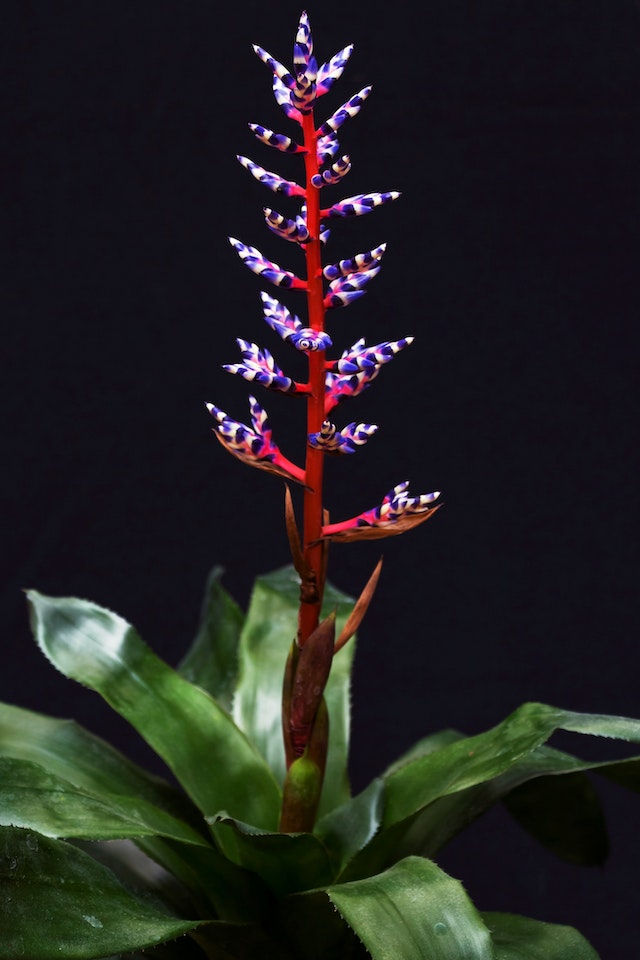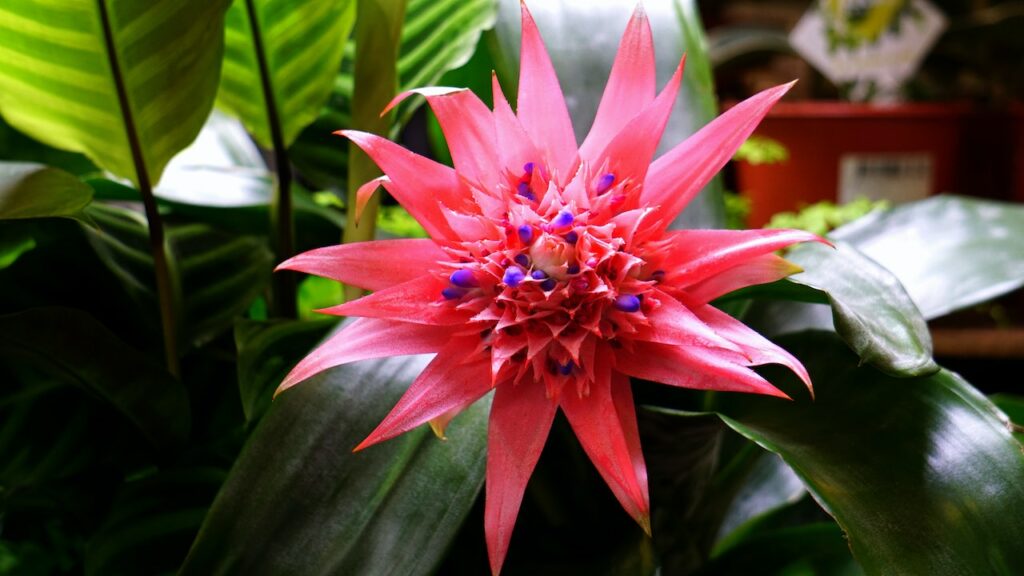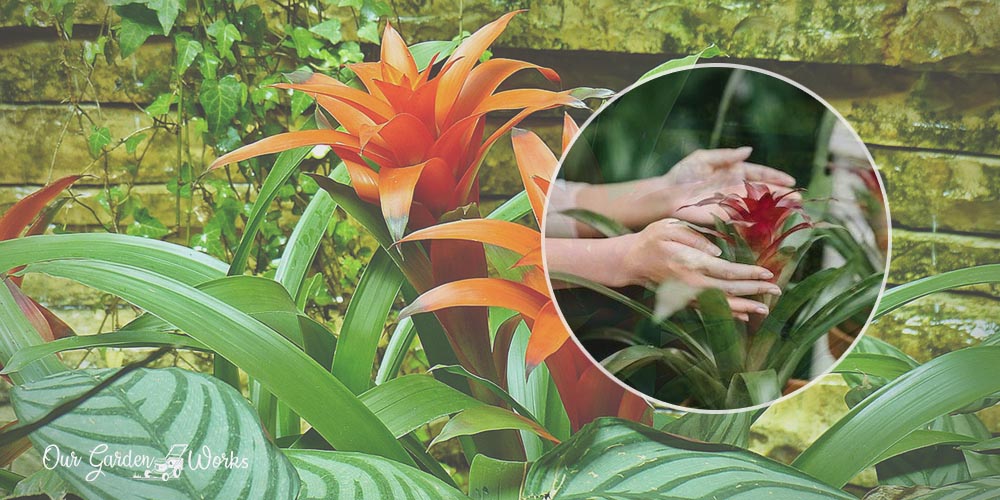Bromeliads are low-maintenance plants that rarely have any problems. However, bromeliad leaves turning yellow is pretty common, especially if you’re a first-time bromeliad grower. Like other house plants, bromeliad comes in varieties that have specific needs.
Plant problems usually occur in bromeliads when the wrong care is given to the wrong variety.
In this post, we will identify the possible causes of leaf chlorosis or yellowing or browning of bromeliad leaves based on their variety and how to treat them.
Bromeliad leaves turning yellow based on Bromeliad variety
Bromeliads have indoor and outdoor varieties which have their specific needs. When those needs are not met, most bromeliads can cope with ease.
They are the unproblematic type of plants but will often show some subtle signs of stress through their leaves.

Bromeliads are as low-maintenance as snake plants and peace lilies. They don’t grow as big as money trees and can only be as high as three feet. Even though bromeliads produce blooms only once in their lifetime, they are generous in developing new pups after they flower.
It can be sad to know that bromeliads only bloom once. However, their flowers can last for 3 to 6 months, which makes their occurrence worthwhile.
Due to that behavior, they are not a pain to fertilize every growing season. Instead, they only need nutrients when they are developing their blooms.
Learn more about indoor and outdoor varieties and the possible causes of bromeliad leaves turning yellow or brown.
Indoor bromeliad varieties
Indoor bromeliads are ideal houseplants since they are very compact and can only grow from 2 to 3 feet. They need bright and indirect sunlight since direct sunlight can ruin their beautiful leaves.
Unlike other houseplants, bromeliads are incapable of rapidly replacing their leaves. So, any leaf damage can visibly affect the overall look of the plant until the whole leaf dies off.
5 Causes of Indoor Bromeliad leaves turning yellow indoors
Bromeliads rarely show some plant problems indoors. However, environmental changes can stress them out and show signs through the yellowing leaves.
Here are some of the possible causes:
(1) Naturally dying leaves: All plants age. Their old leaves often die on their own so new ones will emerge. Sometimes the yellowing leaves are an indication that they have seen better days.
(2) Too much sunlight: Bromeliads will develop scorched leaves when exposed to direct sunlight. Yellowing patches will follow the brown streaks on the leaves as a sign of heat stress.
Healthy bromeliads usually produce leaves with striking green color. On the other hand, they tend to develop dark green leaves when they don’t receive enough light.
(3) Low humidity: Bromeliads are tropical plants that require high humidity levels to keep their leaves plump and healthy. When the weather gets cold and the indoor humidity drops less than 40%, the leaves will show signs of stress.
These include droopy and yellowing leaves. The leaves will also look more sickly and dehydrated.
(4) Heart rot: Heart rot usually develops when water accumulates at the heart of the cup-like center part of bromeliads. When the pathogens of the fungus contaminate the rainwater, they will start causing the following symptoms:
- Yellowing leaves.
- Off-putting smell.
- Black patches develop from the heart of the plant.
- Dropping leaves.
(5) Overwatering: Almost all problems with bromeliads come from overwatering. A part of it is because of their cups that collect water and their nature as a plant with high drought tolerance.
Weekly watering is ideal for bromeliads but if the soil is still moist or the cup is filled with water, it’s best to delay the watering.
Otherwise, the excess moisture will harbor pathogens that lead to root, heart, and leaf rot.
Outdoor bromeliad varieties

Some varieties of bromeliads grow well in an outdoor setting in tropical and subtropical parts of the US. Due to the abundance of space, they often grow wider and in any location like dead trees or stumps.
Unlike indoor bromeliads, outdoor varieties have colorful leaves which are red, yellow, and pink.
The colorful leaves of bromeliads make them an ideal addition to landscape designs. They are often considered the star of landscaped gardens due to their leaf design and color. One of the common landscape staples is the neoregelia bromeliad.
4 Possible Causes of yellowing leaves in outdoor bromeliads
Outdoor bromeliads tend to grow bigger than usual indoor bromeliads. Their vibrant leaves add character to landscapes and add some tropical atmosphere to them.
They’re easy to grow but not exempted from plant issues like yellowing leaves. They rarely have such problems, but when they do, it can be hard to identify the root cause.
If you’re puzzled about the yellowing leaves of your outdoor bromeliads, here are some common causes that gardeners experience:
(1) Overwatering: Bromeliads are drought-tolerant plants. They absorb water through the water collected in their cup-shaped centers and the moisture in the soil.
Usually, they tend to get overwatered since they collect enough water from the rain and also get moisture from daily watering.
The leaves will start to show nutrient deficiency paired with rotting centers since the roots are drowning in excess moisture.
Due to the lack of nutrients, the leaves will start to yellow and slowly rot from the center.
(2) Excessive sunlight: The yellowing bromeliad leaves can also indicate sun dam.
Bromeliads are not a fan of intense direct sunlight. They prefer being nestled in under the shade of trees or roofs while getting the indirect bright light.
According to the University of Florida, the leaves of bromeliads are the best indicator of the amount of light that they absorb. They usually turn pale green to yellow when they receive excessive sun.
(3) Consequent days of low outdoor temperature: Bromeliads can only thrive outdoors in USDA Hardiness zones 9-10.
Some varieties are more tolerant to low temperatures but most bromeliads can suffer from a quick death in below-freezing temperatures for several days.
The temperature that bromeliads enjoy is above 50°F. If you live in Zones 9 or 10, your outdoor bromeliads may need extra protection during cold winter nights like insulator blankets to prevent cold damage. Frost damage in bromeliads often shows brown and yellow patches on the leaves.
If you’re planning to use bromeliads in your landscape garden, better opt for cold-hardy and gardener-favorite aechmeas and neoregelias which are hardy at 32F.
(4) Pest infestation: Outdoor bromeliads are more prone to pest damage than those bromeliads protected indoors. They are not as prone to pest infestation as other plants since healthy bromeliads have high pest resistance.
However, once they get weak, pest and fungal diseases will take advantage of them, leading to yellowing and deformed leaves.
The common pests in outdoor bromeliads are as follows:
1. Rice root aphids: these sap-sucking insects are common in bromeliads grown in Florida.
Heavy aphid infestations usually congregate under the crown-like leaves and feed on the roots, causing dehydration and plant health decline.
2. Red spider mites: Spider mites will also take advantage of the leaf structure of bromeliads and build their tiny webs on them to hide from their predators.
Mild infestations of these bugs don’t usually cause problems but when they start to get worse, the leaves will show signs of stress through yellow or brown streaks.
3. Mealybugs: Mealybugs are white cottony specks that are also feeding on bromeliads. They are harder to remove than aphids due to their tight grip on plant surfaces.
Since they feed on sap, the leaves can become too dehydrated and develop yellowing and browning leaf edges.
4. Fungus gnats: Fungus gnats infestation is often a result of another problem which is overwatering. They are an indication that the soil is too moist and has been attracting pest and fungal pathogens to your plant.
5. Snails and slugs: Bromeliads are the perfect hiding place for slugs. You will rarely notice them at a glance but once you inspect your bromeliads, you will either find them under the leaves or in the cups.
Deformed and yellowing leaves and random droppings are also a sign of slug or snail infestation.
How to treat yellowing of indoor and outdoor bromeliads
Yellowing bromeliad leaves will no longer turn back to green. What you can do is address the plant problem and prevent the other leaves from turning yellow or brown.
Here are some tips on how to treat bromeliads with yellow leaves:
Soil Composition
Make sure that the soil is composed of light materials to prevent overwatering issues. Since bromeliads are drought-tolerant, they need to have light materials that can still retain light moisture.
Most gardeners use the following combination of materials:
- 1/2 potting soil, 1/4 perlite, and 1/4 orchid bark.
- Equal parts of sphagnum peat moss, horticultural perlite, and fine fir bark.
- Equal parts of soil-less potting soil, perlite, and pine bark nuggets.
The soil acidity should be slightly acidic and on pH levels 5 to 6. Otherwise, the roots will fail to absorb nutrients from the soil and prevent it from developing quality flowers. Use a soil pH meter and adjust the pH level when it’s too acidic or alkaline.
If the soil is too acidic, you may apply agricultural lime. If it’s too alkaline, you may apply sulfur to raise the soil acidity.
Bromeliads are heavy feeders right before they produce flowers and putting the soil on the right acidity levels will ensure that the leaves and flowers will be at their best for several months. Once the flower is spent, the plant will sparingly need fertilizers.
Sun exposure and temperature
Bromeliads take sun exposure seriously. They are tropical plants but can’t handle direct sunlight. It’s best to place it under the canopies of trees or away from windows that receive direct sunlight.
Bromeliads are also prone to frost injury in below-freezing temperatures. Some varieties can tolerate prolonged cool temperatures while others can suffer from frost injuries the second day they are exposed to the cold.
According to the University of San Francisco, here are the bromeliad varieties and their hardiness levels:

Bromeliads perform best when they are in a climate with temperatures 70ºF-90ºF during the day and 50ºF-65ºF at night.
Even in tropical and sub-tropical states in the US, they will need extra protection from cool temperatures using insulation and blankets.
Watering and cup water removal
Bromeliads often get overwatering issues because of their cups. Whenever the water accumulates in the cups, bromeliads have a higher chance of experiencing heart rot and salt buildup. So, before or after watering make sure to empty cups and water them lightly.
The soil must be 2 to 3 inches dry before it needs another set of watering. If the soil has not dried up yet, then delay the watering for a day or two.
When the temperatures are high, the humidity is also high and water evaporates faster. That means, the soil dries up faster and will require weekly watering.
In cool temperatures, the humidity is low and the soil moisture will evaporate at a slower rate. So, check the soil accordingly whenever the weather changes and observe the soil before watering.
Fertilization and plant maintenance
Bromeliads are so easy to grow that they don’t need frequent feeding. They will still thrive as long as they are placed in optimal growing conditions.
They will only need an all-purpose fertilizer with NPK 14-14-14 before they bloom to support the development of the flowers.
Once the flower has died, you may stop feeding your bromeliad and keep it to develop its pups or new growth. The pups will replace the plant giving you beautiful blooms for the next growing season.
Since bromeliads only bloom once, some gardeners throw them out immediately but we highly suggest that you keep them for the pups.
Final Thoughts
We hope that this post helped you have an idea why bromeliad leaves turning yellow is something you should not take lightly. It could be anything like root rot, sun damage, or slugs swimming in the cups.
Share your favorite bromeliads n the comments below and how you prevent them from developing yellowing leaves.
Also, please share this post with your friends who have an interest in tropical plants like bromeliads.
